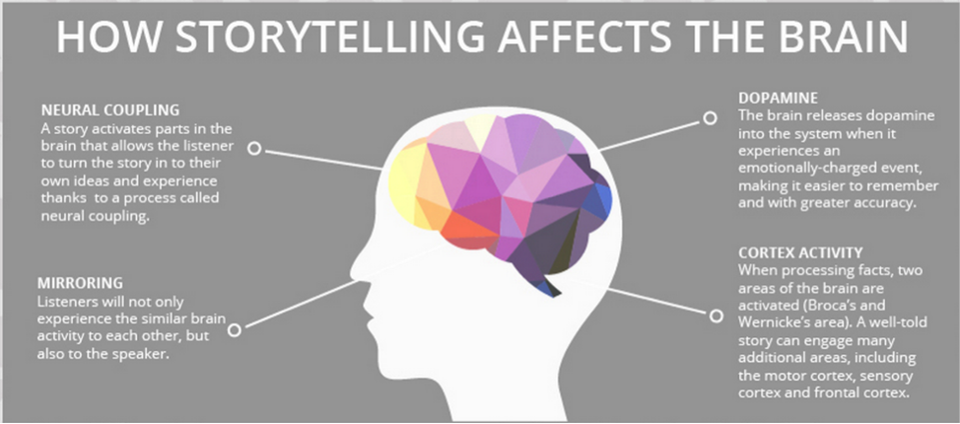How To Leverage Storytelling To Increase Your Influence
Influence is fundamental to your personal brand and ability to lead and impact your audience. It is a skill we exercise every day, whether consciously or not, to shape our environments and the people around us.
As humans, we are wired for connection, and each of us has the opportunity to lead and influence in a way that creates cohesion and cooperation towards a similar goal.
With the rise of social media, the opportunity to connect has never been greater but seldom do we come across content that actually matters.
That’s because many of us have spent so much time researching, gathering information, filtering through data, packaging our findings and then expecting people to show up and buy our products/services automatically.
We forget the most crucial part of the business; that it’s the people that come first.
There’s a well-known marketing axiom that “people buy from people they know, like and trust.”
Personal brand experts know that before going down the “business” route, you must first establish a genuine connection with your audience. Business comes second.
Increasing the effectiveness of your influence relies on your ability to connect through memorable stories that get people committed to your ideas and brand.
Simply put, the best way to make a real impact is through storytelling.
The Science Behind Storytelling
The human brain is wired to receive stories. Stories are universal and have been used across all cultures and generations to pass down knowledge and wisdom since the beginning of time.
A story, in its purest form, is a result of cause and effect. And that is how we as humans think.
From birth, we are story listeners- crafted to learn via storytelling and narratives. We think in narratives whether it is about running errands, what is happening at work or thinking about our friends. We make up stories in our heads for every action and conversation in our daily lives.
The truth is that our brains receive information very differently when told through a story then by merely capturing data and hard information. Mary Helen Immordino-Yang, a neuroscientist and human development psychologist at the Brain and Creativity Institute, found that when we hear inspirational stories, more blood flows to our brain stem – the same part of our brain that makes our heartbeat, regulates our breathing and keeps us alive. This means we feel inspiration at the very core of our biological survival.

From this information, we can conclude that the way that we present information can dramatically change how individuals grasp and understand our messaging. It’s up to us to drive the connection.
When we utilize stories to persuade our audiences, the brains of those receiving the information become synchronized with ours and spark a deep level of connection.
To be an effective influencer, you need to think about how to motivate people toward change by sharing stories that sound and feel unmistakably human.
Finding Your Story
You may not think that you have a story to tell, but you do. You wouldn’t be where you are today without one.
To build a genuine connection, you must begin to look within. Most personal brands obsess over information that they assume their audience needs and neglect the emotional appeal to their current circumstances.
The goal is for you to develop an unmistakable magnetism to your followers, seen as a person who has the power to affect others with the delight that you take in yourself- embracing the good, bad and ugly.
One of the first starting points for creating a series of stories is first to determine your, “Why You Do What You Do” story.
This is a foundational narrative that should be woven into all touch points of your personal brand and easily understood by your audience.
When fully embracing your story, you will begin to notice that your followers will exude the same amount of passion towards your mission that you do. They will love what you love because it is rooted in a deep passion that comes from within.
Here are three helpful tips to keep in mind when crafting your story:
Prioritize Vulnerability
Your story starts with a “defining” moment- raw, vulnerable and real.
Most people stay in a comfort zone because they don’t want to embarrass themselves or risk anything, so they play it safe. Push yourself to go beyond that current capacity and be willing to be generous with your story. Learn to see vulnerability as your greatest ally.
Detail Your Conflict or Struggle
You have multiple defining moments in your life, and they aren’t meant to be hidden from the world.
Didn’t get into that sports team? Experience a break up in the past? Didn’t land your ideal client?
Who or what have you battled in the past? How did you change (or maybe are continuing to) as a result?
Take some time to revisit your major life events. Don’t look for the proud moments, but moments of defeat, conflict, and struggle. Use these stories to craft your unique narrative inviting your audience to go through those emotions with you.
If you neglect the emotional side of your being and jump straight into telling people that you can help change their lives and increase their revenue by xx amount, people will not know what to do with that information.
On the flip side, if you open up about your childhood, shortcomings and why your services have helped you to overcome your barriers, your influence and engagement will become so much more powerful, inspiring people towards real change and action because they know they are not alone.
Unleash the Transformation
The final piece in crafting your story is your transformation. If you think of yourself as a character in your own story, you begin to realize that your character has to change or grow in some way from when the story started to when the story ends. You need to have learned something or had some enlightenment or shifted the way you think about something.
This is the moment of overcoming. The moment that so many of us dream of obtaining. To use emotions effectively, you must be able to empathize with the transformational experiences within yourself.
By speaking from the place of your perspective, you’re able to be authentic and engage with the emotions and imagination of others, helping them see things differently — and act differently as a result.
Your audience’s reward is the opportunity to reap the benefits of your transformation by following your unique blueprint.
Sharing Your Story
Once you have created your foundational story, it’s time to think about how you will go about sharing it with the world.
Here are some guiding questions to help you cohesively share your story:
Goal: What specific outcome do you want to achieve?
Audience: Whom do you need to influence or get input from? What is the impact that you want your story to have on them?
Message: What do you want to say? What tonality will resonate best with
your audience?
Expression: How will you deliver the message (video, email, blog post, social
post)?
Apart from creating your foundational story of, “Why You Do What You Do,” you will then want to begin to think of alternative stories that can be used to help boost your influence.
It might be helpful to create your “Story Toolbox” which is a living folder where you can add different story types, testimonies, and ideas for future sharing.
There are many different stories you can put in your toolbox…so long as they always tie back to your main story: why your brand exists.
A “Purpose Story” is a big picture story that conveys a big idea. Use “Example or Proof Stories” to illustrate how others overcame a similar problem and had a successful outcome. When offering a change-idea, craft a “What If?” or “Imagine…” story.
You can also use teaching stories, inspirational stories, and your own everyday stories to make you more relatable to your audience.
By creating these foundational stories, you are instilling a familiar narrative and message to your audience that will help them to distinguish your voice among the masses, positioning you as the expert and gaining real influence with your followers.
If you are looking to dive deeper into the strategic storytelling world- check out these resources to level up your influence through storytelling:
Pixar’s 22 Rules of Storytelling
Influence by Robert B. Cialdini
StoryCorps- Questions to Inspire Your Storytelling Development
Final Thoughts
Now that you have learned about the science behind storytelling, how to find your story and share it with the world, it’s time for action!
Sharing your experiences, knowledge and personal stories are the key to impacting and influencing others to take your desired action.
So what’s your story? We want to hear. Craft your “Why You Do What You Do” story and drop it down in the comments below!

